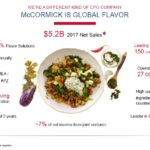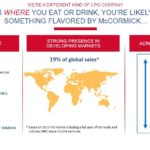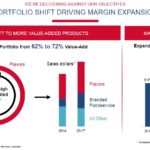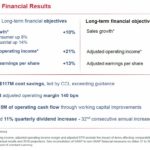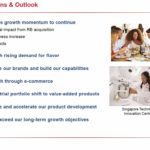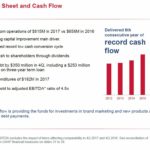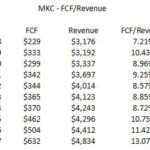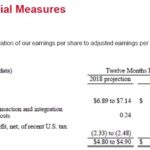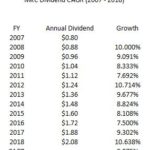Contents
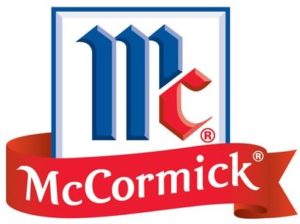 Summary
Summary
- MKC is a dominant provider of spice and seasoning products to the commercial and industrial markets.
- It leveraged its balance sheet to acquire Reckitt Benckiser’s Food Division (‘RBFD’) for ~$4.21B in 2017 but management is committed to a significant reduction in debt levels by the end of fiscal 2020.
- Growth in revenue and margins should enable MKC to generate strong positive free cash flow thus enabling management to reduce debt, maintain the company’s status as a Dividend Aristocrat, and to meet its long-term total shareholder return objective of 11% – 13%.
- MKC represents a long-term attractive investment but I would like the price to retrace to ~$100 from the current ~$110 level before I initiate a position.
Introduction
In my March 30, 2017 article I indicated I would welcome the opportunity to acquire shares in McCormick & Company (NYSE: MKC). At the time, shares were trading at ~$97.50 and based on my analysis I felt a retracement to ~$89 was a level at which I would be prepared to initiate a position.
In July 2017, MKC retraced very briefly to ~$90 around the time that it announced its intent to acquire Reckitt Benckiser’s Food Division (‘RBFD’) for ~$4.21B in cash. In hindsight I should have pulled the trigger but instead I purchased additional shares in MasterCard (NYSE: MA) and initiated a position in Genuine Parts (NYSE: GPC).
Subsequent to the closing of the RBFD acquisition, MKC is certainly a different company from when I last reviewed it. It has added several more market leading brands to its portfolio and because MKC funded the acquisition through the issuance of ~6.35 million shares of non-voting common stock and through new borrowings comprised of senior unsecured notes and pre-payable term loans; MKC’s balance sheet looks very different from early 2017.
I have not lost interest in initiating a position in MKC, and therefore, since it issued its Q4 and FY2017 results on January 25, 2018 and senior management also presented at the Consumer Group of NY Conference on February 20, 2018, this is an opportune time to revisit MKC.
Business Overview
McCormick, established in 1889, is a global leader in flavor. MKC’s history can be viewed here.
It manufactures, markets and distributes spices, seasoning mixes, condiments and other flavorful products to the entire food industry (retailers, food manufacturers and foodservice businesses). It also partners in a number of joint ventures in the manufacture and sale of flavorful products. The most significant of these is McCormick de Mexico.
Its major sales, distribution and production facilities are located in North America, Europe and China with additional facilities based in Australia, Mexico, India, Singapore, Central America, Thailand and South Africa.
PepsiCo (NASDAQ: PEP) and Walmart (NYSE: WMT) are two of MKC’s largest customers and each account for ~11% of total sales.
Through the acquisition of RBFD, MKC added 3 strong brands with ~$0.57B in annual sales to its portfolio.
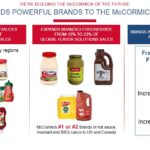 Source: MKC Consumer Analyst Group of NY Conference Presentation – February 20, 2018
Source: MKC Consumer Analyst Group of NY Conference Presentation – February 20, 2018
MKC also acquired Enrico Giotti SpA, a leading Italian flavor manufacturer located in Florence, Italy, in December 2016 for ~$0.127B. The acquisition of Giotti, known in the industry for its innovative beverage, sweet, savory and dairy flavor applications, added annual sales of ~$0.056B. This acquisition expanded the breadth of MKC’s value-added products in the industrial segment and brought additional expertise in flavoring health and nutrition products.
MKC operates through the following Business Segments.
- Consumer: ~61% of sales and 72% of operating income;
- Industrial: ~39% of sales and 28% of operating income.
The following images provide additional high level information regarding MKC. I also recommend you look at the entire February 20, 2018 Consumer Analyst Group of NY Conference presentation.
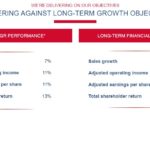 Source: MKC Consumer Analyst Group of NY Conference Presentation – February 20, 2018
Source: MKC Consumer Analyst Group of NY Conference Presentation – February 20, 2018
Impact of the Tax Cuts and Jobs Act (TCJ) on MKC
MKC has indicated its 2018 income tax rate will be significantly impacted by the TCJ with the most significant changes being the positive revaluation of MKC’s U.S. net deferred tax liabilities and the partial offset from the unfavorable impact of a repatriation tax under that legislation. Due to the net favorable effect of those 2 nonrecurring items, MKC expects its FY2018 GAAP tax rate will be negative.
MKC expects its non-GAAP underlying effective tax rate for FY2018, excluding the net favorable effect associated with those 2 nonrecurring items, will be ~24%. The FY2018 tax rate, however, is unlikely to be MKC’s enduring tax rate. It expects its underlying effective tax rate to be slightly higher than ~24% in 2019 and beyond.
Q4 and FY2017 Financial Results and FY 2018 Outlook
MKC’s January 25, 2018 Earnings Release can be found here.
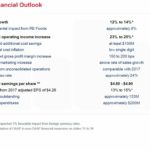 Source: MKC Q4 2017 Financial results and Outlook Presentation – January 25, 2018
Source: MKC Q4 2017 Financial results and Outlook Presentation – January 25, 2018
Credit Ratings
As a result of MKC having leveraged its balance sheet to acquire RBFD, Moody’s downgraded MKC’s senior unsecured credit rating from A2 to Baa2 in August 2017. S&P Global also downgraded MKC from A2 to BBB. Both ratings changed from a mid upper medium grade rating to a mid lower medium grade rating.
When the RBFD acquisition was announced, management stressed its commitment to a strong Investment Grade rating. Focus is on returning to the A2 credit profile with the goal of deleveraging from a 5.1 times leverage ratio as at MKC’s FYE2017 to ~3 times by YE2020.
Free Cash Flow (FCF)
FCF is a key metric upon I which I rely as part of my analysis as it cannot be easily manipulated with one-time charges or events as in the case of earnings.
I generally look for FCF/Revenue in excess of 10% as this level provides me with some comfort the company is generating sufficient cash flow. Looking at the following 10 year analysis, MKC has improved its level of FCF/Revenue.
Valuation
MKC reported FY2017 diluted EPS of $3.72 and adjusted diluted EPS of $4.26; the long-term objective is to grow adjusted diluted EPS by 9% – 11% annually.
The FY2018 forecast is for diluted EPS in the range of $6.89 – $7.14/share and adjusted diluted EPS in the range of $4.80 – $4.90.
Source: MKC Q4 2017 Financial results and Outlook Presentation – January 25, 2018
Using MKC’s March 6, 2018 closing stock price of ~$110 we arrive at a current PE of ~29.6 ($110/$3.72) which is slightly higher than the ~27 PE evidenced over the past 5 years. The forward adjusted PE range is ~22.5 – ~23 and the forward PE is ~15.5 – ~16.
A forward adjusted PE of ~20 or below is what I would be prepared to pay for MKC. On the basis of the FY2018 adjusted diluted EPS projection of $4.80 – $4.90 then a purchase price right around the $100 mark would be an acceptable entry point for me.
Dividend, Dividend Yield, and Dividend Payout Ratio
MKC’s dividend and stock split history can be found here. It is a Dividend Aristocrat having met the enviable record of increasing its dividend for at least 25 consecutive years.
At the time of the RBFD acquisition announcement, investors were informed that the current dividend policy would be maintained. In keeping with this commitment, MKC’s $0.47 quarterly dividend was increased to $0.52 commencing with the January 16, 2018 dividend; this marked the 32nd consecutive year in which MKC’s dividend was increased.
The compound annual growth rate of MKC’s dividend over 2007 – 2018 is as follows:
NOTE: The 2018 annual dividend is on the basis of MKC keeping its recently announced $0.52/quarter dividend constant for 4 quarters.
Based on the March 6, 2018 ~$110 closing stock price, the $2.08 forward annual dividend yields ~1.9%.
On the basis on the projected FY2018 adjusted diluted EPS of $4.80 – $4.90, the $2.08 forward dividend represents a dividend payout ratio of ~42.5% – ~43%. On the basis of $3.65 FCF/share, the forward dividend payout ratio is ~57%. Both levels are acceptable from my perspective.
With management’s objective to deleverage, the share repurchase program has been curtailed indefinitely.
Final Thoughts
In my opinion, MKC’s acquisition of RBFD will have a long-term positive effect even though MKC levered its balance sheet to complete the acquisition. I expect the growth in revenue coupled with margin expansion will generate strong positive cash flow thus allowing MKC to reduce debt levels as planned.
Management is clearly confident in the company’s ability to generate the projected results as evidenced by the recent ~10.6% increase in the quarterly dividend.
Given the above, I am willing to invest in MKC even though the balance sheet is highly leveraged. My only concern at this stage is that MKC is a bit on the expensive side. A retracement to ~$100 is a level at which would be prepared to initiate a position.
Thanks for reading!
Note: I sincerely appreciate the time you took to read this article. Please send any feedback, corrections, or questions to charles@financialfreedomisajourney.com
Disclaimer: I have no knowledge of your individual circumstances and am not providing individualized advice or recommendations. I encourage you not to make any investment decision without conducting your own research and due diligence. You should also consult your financial advisor about your specific situation.
Disclosure: I do not currently hold a position in MKC and do not intend to initiate a position within the next 72 hours.
I wrote this article myself and it expresses my own opinions. I am not receiving compensation for it and have no business relationship with any company whose stock is mentioned in this article.


